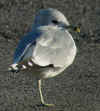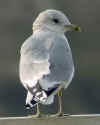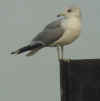|
coordinator:
Kjeld Tommy Pedersen
Home
@
|
Common
Gull is a widespread species on the northern hemisphere with several sub-species: in N America brachyrhynchus,
in W Europe nominate canus, in W Asia and Russia heinei and in the Far
East sub-species kamtschatschensis.
The American race brachyrhynchus is a breeding bird of
Alaska, the American West coast and inland Canada. After the
breeding season, it disperses south along the coast to California. Brachyrhynchus
can be readily told from nominate canus, and therefore
sometimes considered a full species: Mew Gull. The differences can
be found in the bill (in some birds obviously small), but most in
plumage.
Nominate canus is a common breeding bird in North Europe, wintering both in the breeding area and slightly south, to the northern coast of the Mediterranean.
The race heinei breeds from White Russia eastwards to central
Mongolia, in a broad band over the tundra region of inland U.S.S.R.
It can be found wintering in the central Asian states, southern
Black Sea and Caspian Sea and further south to the Persian Gulf.
Part of the eastern population of heinei may follow a more
eastern route to the coast of China. Heinei is slightly darker than the other three sub-species.
Race kamtschatschensis breeds in eastern Siberia and, as the
name indicates, Kamtschatcha. In winter it moves southwards along
the coast, wintering in Japan, the Korea's and China. It is the
largest race, almost as large as Herring Gull. Adult kamtschatschensis
is slightly darker than canus and brachyrhynchus, but
still paler than the central Russian race heinei. The description below largely follows from P.J. Grant: "Gulls, a guide to identification".
1CY
COMMON GULL
In juvenile plumage, the
forehead, throat and nape are white, with the ear-coverts and crown
streaked. The streaks of the hind-neck often create a collar,
running down the sides of the breast into mottled upper-breast and
flanks. The belly and vent are white. In nominate canus, the
upper-tail coverts and rump are white with ill-defined chevrons. The under-tail coverts are
white as well, some with arrow-heads. The scapulars and mantle
feathers are buffish-brown centred with a pale fringe, creating a
scalloped effect. The tertials and inner three or four greater
coverts are brownish centred as well, with a pale buff fringe. The
central and outer greater coverts are more extensive grey-brown,
although the feathers have dark shafts and wedge-shaped centres. The
median coverts, lower lesser and lesser coverts have brown centres,
a dark shaft and buffish fringe, creating a dark carpal bar,
contrasting with the pale greater coverts. The dark secondaries
create another dark bar on the upper-wing. The secondaries have a
white trailing edge, running further onto the inner five primaries.
The four to five inner primaries show pale inner-webs; the outer
primaries and primary-coverts are all dark. The axillaries and
under-wing coverts are white based with black tips, creating lines
over the under-wing. The tail-band is clear-cut in nominate canus,
with the outer tail-feathers largely white. In the race brachyrhynchus
the base of the tail-feathers is mottled, looking completely dark
from a distance. Brachyrhynchus has very obvious patterned juvenile upper-tail coverts.
The partial autumn moult
(moult into so-called "first winter" plumage)
includes the body and head feathers. This moult starts as soon as
the nest is abandoned and continues to late September in nominate canus.
The race heinei, which breeds on northern latitudes may
appear all juvenile well into December. The head and breast are
moulted to second generation feathers, most reminiscent of the
juvenile feathers. The mantle and scapulars are moulted to plain
grey second generation feathers in canus.
Brachyrhynchus in 1cy looks paler on average and more washed-out than nominate canus. In canus,
the second generation scapulars and mantle feathers are plain grey;
in brachyrhynchus, these feathers are often mottled pale
brownish, lacking most of a grey tone. The differences between the
two taxa become more
striking in the first months of 2cy, when the complete wing looks
faded in brachyrhynchus, washed brown, including the primaries. The tail
will be brownish
as well, lacking a clear-cut tail-band as in canus. Brachyrhynchus has the base of the tail-feathers mottled. In general, the upper-tail coverts, head, under-parts and rump are more uniform brown-grey.
2CY
COMMON GULL
The next moult is a partial moult in spring. It starts
in February and is completed by April, leaving birds in so-called "first
summer" plumage. The head turns much whiter, with the
white chin, throat and breast white and dark streaking confined on
the crown, hind-neck. The tertials, wing-coverts, primaries and
tail-feathers are excluded from this moult and turn paler, the grey
parts turn almost white and very worn at the tips. The dark
primaries and the lesser coverts start to bleach to pale brown. The
second generation grey scapulars create a saddle. The legs are
greyish.
From June to October, a complete
moult will bring birds in so-called "second
winter" plumage. The head and hind-neck are strongly
spotted and from the hind-neck, these spots form streaks, creating a
collar running down the sides of the breast. Under-parts,
tail-coverts and rump are white. The second generation primaries
resemble adult primaries, but the black is more extensive in the
outer-wing, with black sub-terminal markings down to P4 or even to
P3. The greater and median primary coverts and the lesser coverts in
the carpal edge are dark centred as well. The white tips on the
outer primaries are ill-defined, wearing off quickly and the mirrors
on P9 and P10 are smaller than in full adult plumage. The tail is
all-white in race canus. The iris is brown, the greyish bill has a clear black bill-band.
After the complete moult in June to
October, brachyrhynchus may still show several immature
feathers in the wing. The central tertials and some of the tail-feathers
may show dark immature centres (even creating some kind of a
tail-band in some individuals). Immature features can also be found
in the central greater coverts and in the
carpal edge and can even be found on the upper-tail and under-tail coverts.
These immature features are less often found in nominate canus,
which show no vestiges of a tail-band from autumn 2cy onwards
("second winter" plumage and later). In this respect, brachyrhychus
resembles Ring-billed
Gull, L. delawarensis. From autumn 2cy onwards, the
iris in brachyrhynchus may turn obvious pale.
The race kamtschatschensis shows similar amount of patterning
after the complete moult as brachyrhynchus, with many
immature markings in tail, tertials and wing-coverts. Moreover,
(all?) kamtschatschensis still shows black tips on the white under-wing coverts.
3CY
COMMON GULL
The next moult is a partial moult in spring. It starts
in February and is completed by April, leaving birds in so-called "second
summer" plumage. The head turns white, with only a few
dark markings in some birds. The small primary tips wear off and the
black areas turn paler, brownish.
From early summer to October, a complete
moult will bring birds in so-called "third
winter" or "adult winter" plumage.
The head is white with spots, most densely in the hind-neck. The
under-parts, tail-coverts and rump are white. The upper-parts are
medium grey, with broad white fringes on the tertials. The third
generation primaries and later the adult primaries have a clear-cut
black triangle on the outer-wing. Black sub-terminal markings run
down to P6 or P5. From P1-P9 the primaries show extensive white tips
and the two mirrors on P9 and P10 are obvious (there may even be a
small mirror on P8). The iris is brown, the bill is yellowish with a
faint black bill-band and the legs are yellowish, greenish or
greyish, often with a flesh-coloured hue.
In adult winter, brachyrhynchus develops only diffuse head streaking,
creating a diffuse grey head and no dark bill-band, whereas canus
often has the head strongly mottled or streaked and often develops a
full bill-band in winter. Furthermore, the iris in brachyrhynchus is
paler, sometimes clear yellow.
ADULT COMMON
GULL
The next moult is a partial moult in spring. It starts
in February and is completed by April, leaving birds in so-called "adult
summer" plumage. The head turns white, with a red
orbital ring. The bill turns all yellow or yellowish-green. In summer, head, neck, tail and under-parts are completely
white. The upper-parts are medium grey.
The outer primaries are black with large white tips. The inner primaries
and secondaries are pale grey with a white tip, creating a white trailing
edge. The white crescents on the tertials are very broad.
Adult brachyrhychus
normally have a black sub-terminal band on P5-P10. Between this
black band and the grey centre, a large white spot is visible both
from above and below on P5-P7, creating a string of pearls on these
primaries. P9 and P10 show large white mirrors.
Measurements in mm's: wing canus: 320-385 (Dwight), 321-380 (Birds of West. Paleartic III), tail: 124-148, bill: 30-38, tarsus: 48-58; n = 16 (Dwight, 1925);
wing heinei: 351-395 (BWP III);
wing brachyrhynchus: 328-366 (Dwight 1925);
wing kamtschatschensis: 365-412 (BWP III).
|
 Common Gull
canus 1cy, July 13 2002, Dintelhaven, Maasvlakte,
the Netherlands. A recently fledged juvenile. Common Gull
canus 1cy, July 13 2002, Dintelhaven, Maasvlakte,
the Netherlands. A recently fledged juvenile. |
 Common Gull
canus C98S,
August 12 2002, Tampere, Finland. A recently fledged juvenile. Common Gull
canus C98S,
August 12 2002, Tampere, Finland. A recently fledged juvenile. |
 Common Gull
canus 2cy, January 04 2002, Etaples / Boulogne-sur-Mer, France (50.42N,1.34E). Common Gull
canus 2cy, January 04 2002, Etaples / Boulogne-sur-Mer, France (50.42N,1.34E). |
 Common Gull
canus 2cy, January 05 2002, Etaples / Boulogne-sur-Mer, France (50.42N,1.34E). Common Gull
canus 2cy, January 05 2002, Etaples / Boulogne-sur-Mer, France (50.42N,1.34E). |
 Common Gull
canus 2cy, February 09 2003, Etaples / Boulogne-sur-Mer, France (50.42N,1.34E). Common Gull
canus 2cy, February 09 2003, Etaples / Boulogne-sur-Mer, France (50.42N,1.34E). |
 Common Gull
canus 2cy, March 16 2003, Etaples / Boulogne-sur-Mer, France (50.42N,1.34E). Common Gull
canus 2cy, March 16 2003, Etaples / Boulogne-sur-Mer, France (50.42N,1.34E). |
 Common Gull
canus 2cy, March 16 2003, Etaples / Boulogne-sur-Mer, France (50.42N,1.34E). Common Gull
canus 2cy, March 16 2003, Etaples / Boulogne-sur-Mer, France (50.42N,1.34E). |
 Common Gull
canus 2cy, March 16 2003, Etaples / Boulogne-sur-Mer, France (50.42N,1.34E). Common Gull
canus 2cy, March 16 2003, Etaples / Boulogne-sur-Mer, France (50.42N,1.34E). |
 Common Gull
canus 2cy, March 16 2003, Etaples / Boulogne-sur-Mer, France (50.42N,1.34E). Common Gull
canus 2cy, March 16 2003, Etaples / Boulogne-sur-Mer, France (50.42N,1.34E). |
 Common Gull
canus 2cy, July 16 2004, Tampere, Finland (61.31N, 23.43E). Common Gull
canus 2cy, July 16 2004, Tampere, Finland (61.31N, 23.43E). |
 Common Gull
canus 2cy, October 24 2002, Etaples / Boulogne-sur-Mer, France (50.42N,1.34E). Common Gull
canus 2cy, October 24 2002, Etaples / Boulogne-sur-Mer, France (50.42N,1.34E). |
 Common Gull
canus 3cy, February 06 2003, Etaples / Boulogne-sur-Mer, France (50.42N,1.34E). Common Gull
canus 3cy, February 06 2003, Etaples / Boulogne-sur-Mer, France (50.42N,1.34E). |
 Common Gull
canus 3cy, March 16 2003, Etaples / Boulogne-sur-Mer, France (50.42N,1.34E). Common Gull
canus 3cy, March 16 2003, Etaples / Boulogne-sur-Mer, France (50.42N,1.34E). |
|
 Common Gull
canus adult, January 03 2002, Le Portel / Boulogne-sur-Mer, France (50.42N,1.34E). Common Gull
canus adult, January 03 2002, Le Portel / Boulogne-sur-Mer, France (50.42N,1.34E). |
 Common Gull
canus adult, January 03 2002, Le Portel / Boulogne-sur-Mer, France (50.42N,1.34E). Common Gull
canus adult, January 03 2002, Le Portel / Boulogne-sur-Mer, France (50.42N,1.34E). |
 Common Gull
canus adult, January 04 2002, Etaples / Boulogne-sur-Mer, France (50.42N,1.34E). Common Gull
canus adult, January 04 2002, Etaples / Boulogne-sur-Mer, France (50.42N,1.34E). |
 Common Gull
canus adult, February 06 2003, Etaples / Boulogne-sur-Mer, France (50.42N,1.34E). Common Gull
canus adult, February 06 2003, Etaples / Boulogne-sur-Mer, France (50.42N,1.34E). |
 Common Gull
canus adult, February 06 2003, Etaples / Boulogne-sur-Mer, France (50.42N,1.34E). Common Gull
canus adult, February 06 2003, Etaples / Boulogne-sur-Mer, France (50.42N,1.34E). |
 Common Gull
canus adult,
February 06 2003, Etaples / Boulogne-sur-Mer, France (50.42N,1.34E). Common Gull
canus adult,
February 06 2003, Etaples / Boulogne-sur-Mer, France (50.42N,1.34E). |
 Common Gull
canus adult,
February 07 2003, Le Portel / Boulogne-sur-Mer, France (50.42N,1.34E). Common Gull
canus adult,
February 07 2003, Le Portel / Boulogne-sur-Mer, France (50.42N,1.34E). |
|
 Common Gull
canus adult, March
16 2003, Le Portel / Boulogne-sur-Mer, France (50.42N,1.34E). Common Gull
canus adult, March
16 2003, Le Portel / Boulogne-sur-Mer, France (50.42N,1.34E). |
 Common Gull
canus adult, March
16 2003, Le Portel / Boulogne-sur-Mer, France (50.42N,1.34E). Common Gull
canus adult, March
16 2003, Le Portel / Boulogne-sur-Mer, France (50.42N,1.34E). |
 Common Gull
canus adult, March
16 2003, Le Portel / Boulogne-sur-Mer, France (50.42N,1.34E). Common Gull
canus adult, March
16 2003, Le Portel / Boulogne-sur-Mer, France (50.42N,1.34E). |
 Common Gull
canus adult E
164300, March 25 2004, IJmuiden, the Netherlands (52.27N 04.33E). A bird ringed in Belgium. Common Gull
canus adult E
164300, March 25 2004, IJmuiden, the Netherlands (52.27N 04.33E). A bird ringed in Belgium. |
 Common Gull
canus adult E592,
March 30 2002, Dintelhaven, Maasvlakte, the Netherlands. A bird
ringed as an adult at the current spot. Common Gull
canus adult E592,
March 30 2002, Dintelhaven, Maasvlakte, the Netherlands. A bird
ringed as an adult at the current spot. |
 Common Gull
canus adult, March 30
2002, Dintelhaven, Maasvlakte, the Netherlands. Common Gull
canus adult, March 30
2002, Dintelhaven, Maasvlakte, the Netherlands. |
|
|
 Common Gull
canus adult, April
22 2002, Dintelhaven, Maasvlakte, the Netherlands. Common Gull
canus adult, April
22 2002, Dintelhaven, Maasvlakte, the Netherlands. |
 Common Gull
canus NLA,
May 16 2004, Dintelhaven - Maasvlakte, the Netherlands. Common Gull
canus NLA,
May 16 2004, Dintelhaven - Maasvlakte, the Netherlands. |
 Common Gull
canus adult, June 02 2003, Vuurtorenvlakte - Maasvlakte, the Netherlands. Common Gull
canus adult, June 02 2003, Vuurtorenvlakte - Maasvlakte, the Netherlands. |
 Common Gull
canus E419
adult, June 22 2003, Dintelhaven - Maasvlakte, the Netherlands. Common Gull
canus E419
adult, June 22 2003, Dintelhaven - Maasvlakte, the Netherlands. |
 Common Gull
canus adult, July 14 2001, IJmuiden, the Netherlands. Common Gull
canus adult, July 14 2001, IJmuiden, the Netherlands. |
 Common Gull
canus adult, July 16 2004, Tampere, Finland (61.31N,
23.43E). Common Gull
canus adult, July 16 2004, Tampere, Finland (61.31N,
23.43E). |
 Common Gull
canus T-117.62?,
July 16 2004, Tampere, Finland (61.31N,
23.43E). Common Gull
canus T-117.62?,
July 16 2004, Tampere, Finland (61.31N,
23.43E). |
 Common Gull
canus adult, July 16 2004, Tampere, Finland (61.31N,
23.43E). Common Gull
canus adult, July 16 2004, Tampere, Finland (61.31N,
23.43E). |
 Common Gull
canus adult,
October 24 2002, Etaples / Boulogne-sur-Mer, France (50.42N,1.34E). Common Gull
canus adult,
October 24 2002, Etaples / Boulogne-sur-Mer, France (50.42N,1.34E). |
|
 Common
Gull- Stormmeeuw (L. canus)
Common
Gull- Stormmeeuw (L. canus)